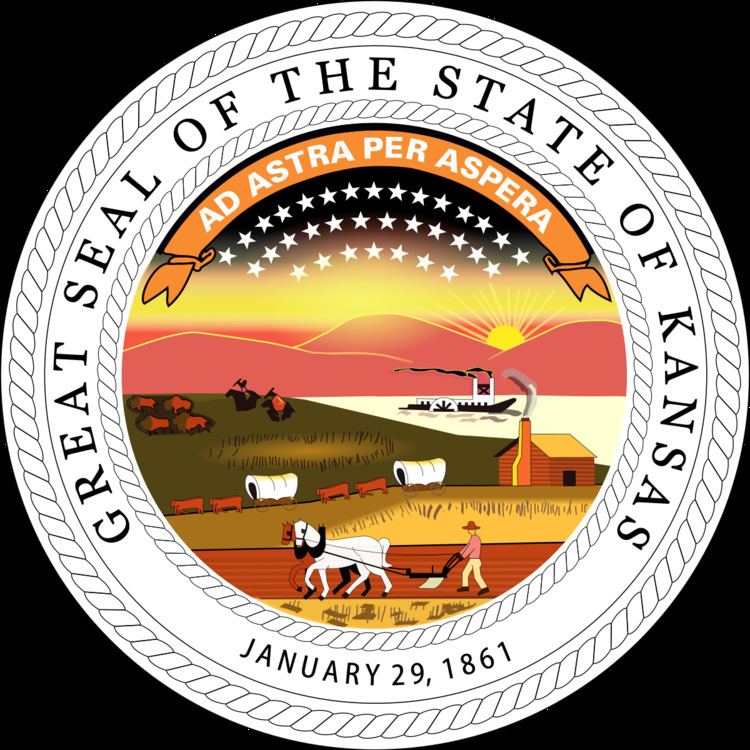November 6, 2012 (2012-11-06) 2014 → 0 0 0 0 | 4 0 4 0 740,981 195,505 | |
 | ||
The 2012 United States House of Representatives elections in Kansas were held on Tuesday, November 6, 2012 to elect the four U.S. Representatives from the state of Kansas. The elections coincided with the elections of other federal and state offices, including a quadrennial presidential election.
Contents
Redistricting
The 2010 United States Census reflected a shift of population "primarily from rural western and northern Kansas to urban and suburban areas in the eastern part of the state."
In spite of Republican political control of the governor's office, the state senate, the state house, and the entire U.S. Congressional delegation, redistricting had to be decided by a federal court. To decide the case, a three-judge panel was appointed by Mary Beck Briscoe, the Chief Judge of the Court of Appeals for the 10th Circuit: Briscoe appointed herself, along with two judges from the District Court for Kansas: Chief District Judge Kathryn Hoefer Vratil, and District Judge John Watson Lungstrum.
According to the Court:
While legislators publicly demurred that they had done the best they could, the impasse resulted from a bitter ideological feud—largely over new Senate districts. The feud primarily pitted GOP moderates against their more conservative GOP colleagues. Failing consensus, the process degenerated into blatant efforts to gerrymander various districts for ideological political advantage and to serve the political ambitions of various legislators.
Once redistricting was finalized in federal court, primary elections were held on August 7, 2012.
District 1
The redrawn 1st district will continue to encompass all or parts of 62 counties in western and central Kansas, and also taking in a sliver of the Flint Hills region. The district will now also include Pottawatomie and Riley counties, including Manhattan and Kansas State University, but will no longer include Barber, Comanche, Edwards, Kiowa, Pratt, and Stafford counties, and parts of Greenwood, Marshall, Nemaha, and Pawnee counties.
Republican Tim Huelskamp, who has represented the 1st district since 2011, is running for re-election. Huelskamp is running without challengers from any party.
District 2
The redrawn 2nd district will continue to encompass Allen, Anderson, Atchison, Bourbon, Brown, Cherokee, Coffey, Crawford, Doniphan, Franklin, Jackson, Jefferson, Labette, Leavenworth, Linn, Neosho, Osage, Shawnee, Wilson, and Woodson, and parts of Douglas, Miami, and Nemaha counties. The district will now also include Montgomery County, parts of Marshall County, and the remainder of Douglas and Nemaha counties, but will no longer include Pottawatomie, Riley, and parts of Miami counties. The district lost Kansas State University to the first district, but gained the state's other major college, the University of Kansas.
Republican Lynn Jenkins, who has represented the 2nd district since 2009, is running for re-election.
Tobias Schlingensiepen, a pastor and police chaplain from Topeka, sought and received the Democratic nomination. He defeated Ottawa farmer Scott Barnhart and Lawrence attorney Bob Eye in the Aug. 7th primary.
Dennis Hawver is running as the Libertarian nominee.
District 3
The redrawn 3rd district will continue to encompass Johnson and Wyandotte counties. The district will now also include the northeastern part of Miami County, but will no longer include the eastern part of Douglas County.
Republican Kevin Yoder, who has represented the 3rd district since 2011, is running for re-election. Joel Balam, a college professor, ran as the Libertarian nominee. Even though he lost, Balam's 31.5% set a new record for the highest percentage a Libertarian candidate ever received in any U.S. House election, mostly because Yoder had no Democratic opponent running against him.
District 4
The redrawn 4th district will continue to encompass Butler, Chautauqua, Cowley, Elk, Harper, Harvey, Kingman, Sedgwick, and Sumner counties, as well as the southern part of Greenwood county. The district will now also include Barber, Comanche, Edwards, Kiowa, Pratt, and Stafford counties, the remainder of Greenwood County, and the southwestern part of Pawnee County, but will no longer include Montgomery County.
Republican Mike Pompeo, who has represented the 4th district since 2011, is running for re-election. Robert Tillman, a retired court officer who ran in the Democratic primary for the seat in 2010, sought and received the Democratic nomination to challenge Pompeo. He defeated Esau Freeman, a painter, in the Democratic primary. Former state Representative Raj Goyle, who unsuccessfully challenged Pompeo as the Democratic nominee in 2010, chose not to run.
Thomas Jefferson, a computer technician formerly known as Jack Talbert, is running as the Libertarian nominee.
